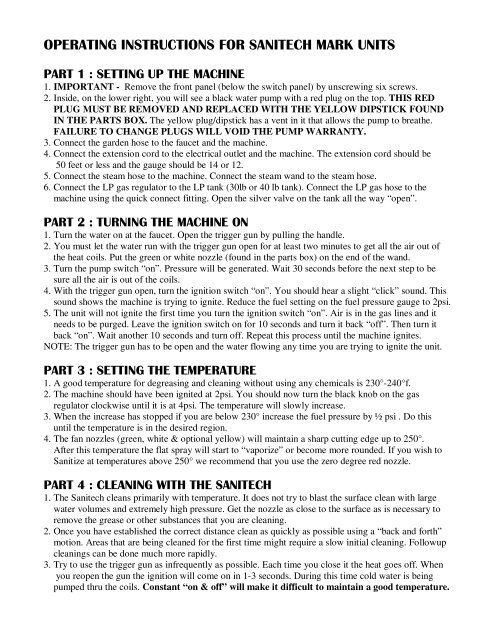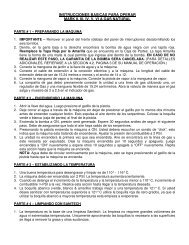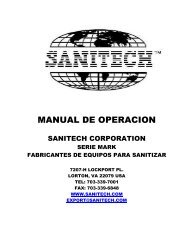Sanitech Mark II, III, IV, V and VI - LP GAS
Sanitech Mark II, III, IV, V and VI - LP GAS
Sanitech Mark II, III, IV, V and VI - LP GAS
You also want an ePaper? Increase the reach of your titles
YUMPU automatically turns print PDFs into web optimized ePapers that Google loves.
OPERATING INSTRUCTIONS FOR SANITECH MARK UNITS<br />
PART 1 : SETTING UP THE MACHINE<br />
1. IMPORTANT - Remove the front panel (below the switch panel) by unscrewing six screws.<br />
2. Inside, on the lower right, you will see a black water pump with a red plug on the top. THIS RED<br />
PLUG MUST BE REMOVED AND REPLACED WITH THE YELLOW DIPSTICK FOUND<br />
IN THE PARTS BOX. The yellow plug/dipstick has a vent in it that allows the pump to breathe.<br />
FAILURE TO CHANGE PLUGS WILL VOID THE PUMP WARRANTY.<br />
3. Connect the garden hose to the faucet <strong>and</strong> the machine.<br />
4. Connect the extension cord to the electrical outlet <strong>and</strong> the machine. The extension cord should be<br />
50 feet or less <strong>and</strong> the gauge should be 14 or 12.<br />
5. Connect the steam hose to the machine. Connect the steam w<strong>and</strong> to the steam hose.<br />
6. Connect the <strong>LP</strong> gas regulator to the <strong>LP</strong> tank (30lb or 40 lb tank). Connect the <strong>LP</strong> gas hose to the<br />
machine using the quick connect fitting. Open the silver valve on the tank all the way “open”.<br />
PART 2 : TURNING THE MACHINE ON<br />
1. Turn the water on at the faucet. Open the trigger gun by pulling the h<strong>and</strong>le.<br />
2. You must let the water run with the trigger gun open for at least two minutes to get all the air out of<br />
the heat coils. Put the green or white nozzle (found in the parts box) on the end of the w<strong>and</strong>.<br />
3. Turn the pump switch “on”. Pressure will be generated. Wait 30 seconds before the next step to be<br />
sure all the air is out of the coils.<br />
4. With the trigger gun open, turn the ignition switch “on”. You should hear a slight “click” sound. This<br />
sound shows the machine is trying to ignite. Reduce the fuel setting on the fuel pressure gauge to 2psi.<br />
5. The unit will not ignite the first time you turn the ignition switch “on”. Air is in the gas lines <strong>and</strong> it<br />
needs to be purged. Leave the ignition switch on for 10 seconds <strong>and</strong> turn it back “off”. Then turn it<br />
back “on”. Wait another 10 seconds <strong>and</strong> turn off. Repeat this process until the machine ignites.<br />
NOTE: The trigger gun has to be open <strong>and</strong> the water flowing any time you are trying to ignite the unit.<br />
PART 3 : SETTING THE TEMPERATURE<br />
1. A good temperature for degreasing <strong>and</strong> cleaning without using any chemicals is 230°-240°f.<br />
2. The machine should have been ignited at 2psi. You should now turn the black knob on the gas<br />
regulator clockwise until it is at 4psi. The temperature will slowly increase.<br />
3. When the increase has stopped if you are below 230° increase the fuel pressure by ½ psi . Do this<br />
until the temperature is in the desired region.<br />
4. The fan nozzles (green, white & optional yellow) will maintain a sharp cutting edge up to 250°.<br />
After this temperature the flat spray will start to “vaporize” or become more rounded. If you wish to<br />
Sanitize at temperatures above 250° we recommend that you use the zero degree red nozzle.<br />
PART 4 : CLEANING WITH THE SANITECH<br />
1. The <strong>Sanitech</strong> cleans primarily with temperature. It does not try to blast the surface clean with large<br />
water volumes <strong>and</strong> extremely high pressure. Get the nozzle as close to the surface as is necessary to<br />
remove the grease or other substances that you are cleaning.<br />
2. Once you have established the correct distance clean as quickly as possible using a “back <strong>and</strong> forth”<br />
motion. Areas that are being cleaned for the first time might require a slow initial cleaning. Followup<br />
cleanings can be done much more rapidly.<br />
3. Try to use the trigger gun as infrequently as possible. Each time you close it the heat goes off. When<br />
you reopen the gun the ignition will come on in 1-3 seconds. During this time cold water is being<br />
pumped thru the coils. Constant “on & off” will make it difficult to maintain a good temperature.
1. Close the trigger gun <strong>and</strong> walk back to the machine. Turn the ignition switch “off”.<br />
2. Reopen the trigger gun <strong>and</strong> allow the cold water to pump through the machine until the temperature<br />
is down around 100°.<br />
3. When the steam hose is cool enough to touch you can turn the pump switch “off”. At this point turn<br />
the silver knob on the <strong>LP</strong> gas tank all the way clockwise to the closed position.<br />
4. You can now turn the inlet water off <strong>and</strong> disconnect everything.<br />
¡¢£¤¥£¦¢§¨§©£¡¨§<br />
PART 6 : THINGS TO KNOW<br />
1. Never store the <strong>Sanitech</strong> in an area that is not heated. If the machine freezes the water inside will<br />
exp<strong>and</strong> <strong>and</strong> crack the coils. More than one hole in the coils is as sure sign of freezing.<br />
2. Never operate the <strong>Sanitech</strong> in a temperature controlled environment like a meat locker or a<br />
cold room where air is only recirculated <strong>and</strong> not exchanged. If you want to clean these areas leave<br />
the unit outside in the normal plant environment where you have natural or forced ventilation. You<br />
can run the steam hose into the cold storage area. Extra lengths of steam hose are available for this.<br />
3. Never use hot water on the intake of the <strong>Sanitech</strong>. The <strong>Sanitech</strong> will accept cold or warm water<br />
up to 140°. At temperatures above 140° you will activate the thermal relief valve <strong>and</strong> the hot water<br />
will be dumped on the ground. This is to save you from hot water damage to the pump.<br />
4. Never operate the <strong>Sanitech</strong> at a fuel pressure reading of 8 psi or greater. Locking nuts have been<br />
installed beneath the black knob on the <strong>LP</strong> gas regulator to prevent usage above 8psi. Removing these<br />
locking nuts <strong>and</strong> operating at high fuel pressures can lead to incomplete combustion <strong>and</strong> the release<br />
of carbon monoxide.<br />
5. Never turn the pump on when water is not running through the machine. Water removes excessive<br />
heat from the pump. Running the pump dry will cause pump failure.<br />
6. Always have your employees wear gloves when using the <strong>Sanitech</strong>.<br />
7. Freezing of the <strong>LP</strong> gas tank. When the tank starts to empty a moist film will start at the bottom of the<br />
tank. As it empties further this film will become a frost. When the frost line reaches mid-tank you will<br />
notice the fuel pressure on the gauge start to drop. This is the time to switch to a new tank. When your<br />
old tank has heated back up to room temperature you can use it again. When the freezing starts to<br />
happen quickly it is time to refill the tank. The larger the tank the longer you can go before freezing<br />
occurs.<br />
8. Keep the nozzles free of dirt. When small amounts of dirt get into the nozzle you will notice a disruption<br />
in the flat fan spray pattern. You should remove the nozzle <strong>and</strong> tap it to remove the dirt. If<br />
a large blockage occurs the ignition will terminate automatically.<br />
9. Scale buildup. The #1 cause of pump damage is scale from hard water building up in the heat coils.<br />
Scale restricts the opening in the coils thru which the pump pushes the water. When scale buildup<br />
becomes excessive you will detect a lower pressure at the nozzle due to a restricted water flow. If<br />
you are in an area with hard water you should use a water filter (available from <strong>Sanitech</strong>) or descale<br />
your machine on a regular basis.<br />
10. Never leave the unit unattended with the pump “on”. The pump will eventually overheat <strong>and</strong><br />
activate the thermal relief. Also, employees not trained on the <strong>Sanitech</strong> might use it.<br />
11. Never hook the <strong>Sanitech</strong> up to a high pressure water line. The <strong>Sanitech</strong> should be operated on a<br />
water line that has normal city/county pressure. If you only use high pressure lines you will have to<br />
use a pressure reducer on the intake of the <strong>Sanitech</strong>.<br />
12. Check the oil level in the pump at least once a month. This is the only maintenance required. The<br />
yellow dipstick (in PART 1) is where you check the oil level. The oil should be within the cutout<br />
portion of the dipstick. If low add 30 wt non-detergent automotive oil. You should also change the<br />
oil yearly. See the manual for details.




